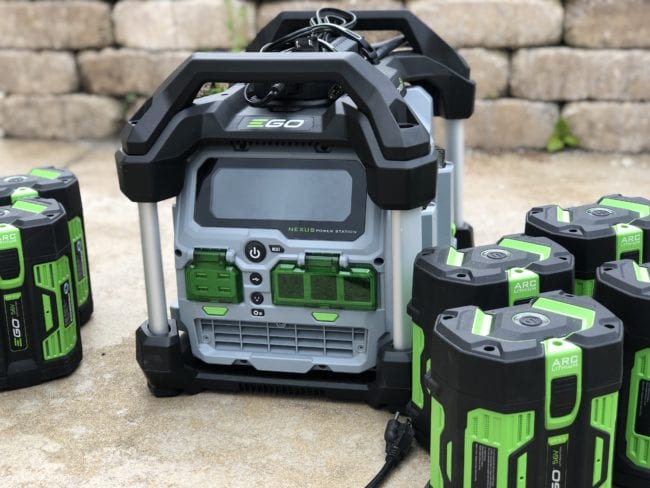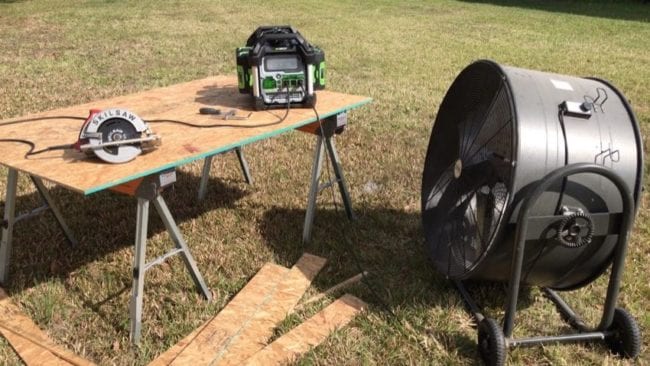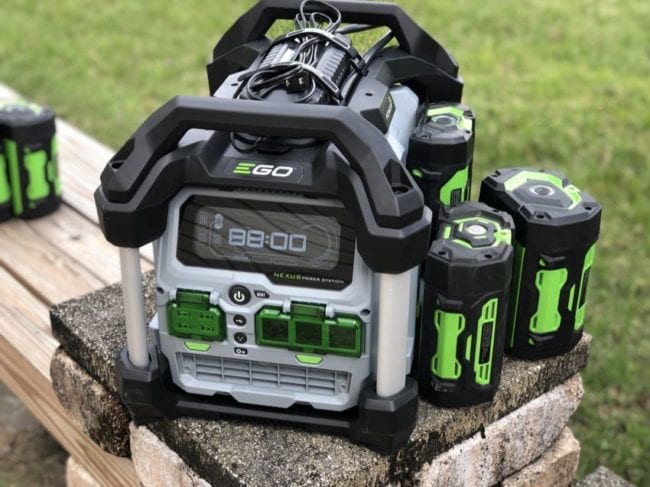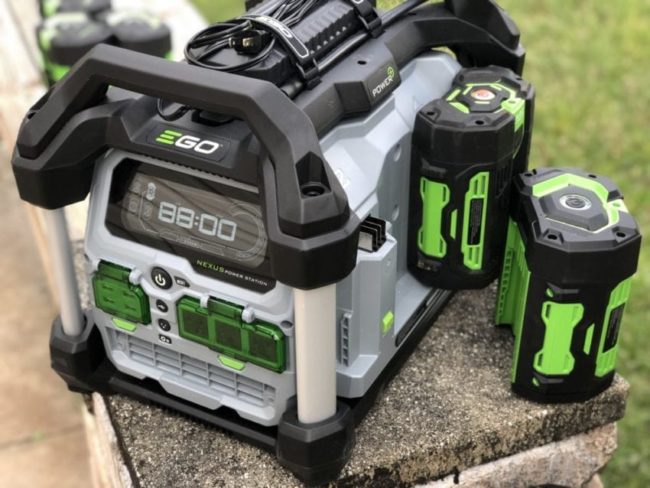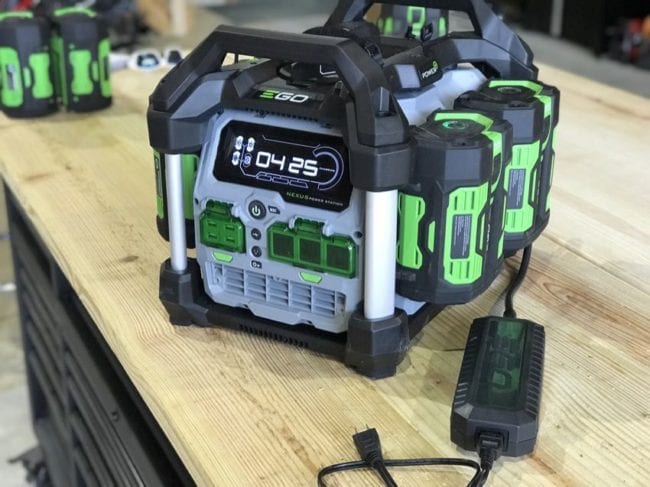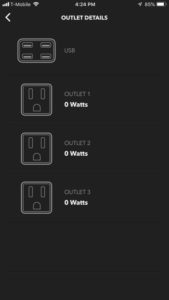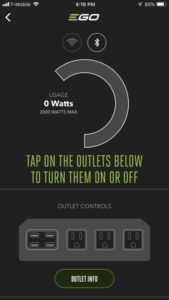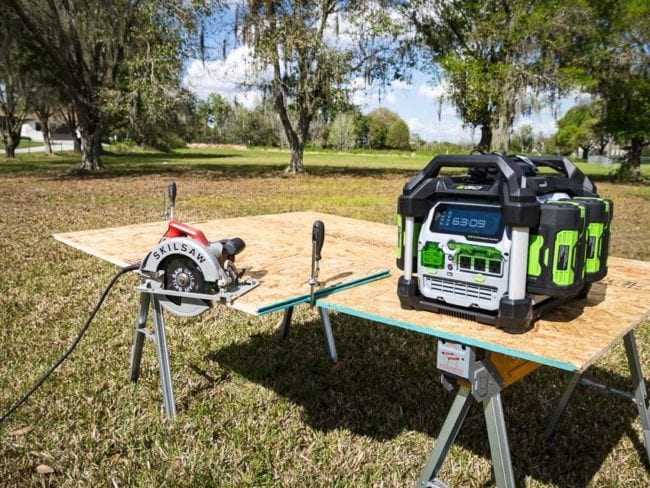EGO Nexus Power Station Runs More Powerful Tools Than Other Battery Inverters
The EGO Nexus Power Station is giving lithium-ion power supplies a kick in the pants with its unorthodox design. I say unorthodox, but outside of the Kohler enCube and Goal Zero products, there aren’t many big names in the battery-powered inverter space taking on 2000-watt gas generator/inverters, so I guess they’re all unorthodox.
Pros
- Flexible lithium-ion power source options – use one to four EGO 56V batteries in any capacity combination
- Nearly silent, emission-free power
- 2000-watt continuous power handles up to 3000 surge watts
- Easily replaceable/upgradable batteries
- Large, bright LCD screen
- Simple yet useful app offers controls and more detailed info
- Handles some 15-amp tools and has higher output than other battery-powered options
- Firmware updates offer easy and free upgrades down the road
- Roll cage offers extra protection
Cons
- Onboard capacity is well under Goal Zero’s max
- Won’t make it past the startup surge of all 15-amp motors
Recommendation
The EGO Nexus Power Station is the most capable battery-powered inverter we’ve seen so far and lets you run tools up to 15-amp handheld worm drives. That may get even better with firmware updates. While it’s short of matching the total capacity of the Goal Zero Yeti 3000 on its own, the flexible design makes it easy to carry extra batteries in reserve if you need them. Whether you’re looking for no emissions, low noise, or just need to run your power source inside, the EGO Nexus Power Station is pushing your access to reliable power further.
Output
The EGO Nexus Power Station is capable of putting out up to 2000 continuous watts with 3000 peak watts out. Those are pure sine surge watts and at 50% over its continuous output rating, it exceeds what a 2000-watt gas generator/inverter can do by a long shot.
There’s a caveat here, though. The Power Station runs on any EGO 56V batteries and there are 4 ports you can use. But you don’t have to use all of them – you can use just 1 if you want. The type of battery determines your output watts. With a 1P pack (2.5 Ah), it runs at 600 watts and bumps up to 1200 watts with a 2P (5 Ah) pack. To get the 2000-watt maximum, you need to run at least one 3P (7.5 Ah).
It’s really about the number of cells – EGO’s 56V battery runs on 14-cell groups. 14 cells on the Power Station gives you 600 watts, 28 cells bump to 1200 watts, and 42 cells or more will run at 2000 watts no matter what combination of batteries you use.
You can also mix batteries sizes with no issue. When you mix different battery capacities or charge states, the Nexus will draw down the highest one(s) first until they’re all at the same level before pulling equally from each pack together.
Real World Testing
So what can you do with 2000 continuous/3000 surge watts?
Goal Zero’s Yeti 3000 moved us into the 13-amp range for corded tools. The EGO Nexus Power Station will run 15-amp tools. I started with a standard 15-amp sidewinder circular saw cutting 1/2″ OSB subfloor and then stacked it to make 1″ cuts with a 15-amp worm drive. Even pushing the worm drive, I didn’t trip the Power Station.
Out of curiosity (and because it was 85º in mid-February), I plugged in our 17,500 CFM drum fan and ran it on high to see if I could still cut with that sidewinder at the same time. It turns out that I can. However, it’s possible to trip the unit’s safety if you push too hard. The fan puts out an additional 900 watts/7.3 amps and pushing the saw hard gets the total watts higher than the 2000 it can hold continuously.
We also tested Skilsaw’s larger worm drive table saw and that seems to be where the limit lies. It can’t handle the startup surge currently.
I say “currently” intentionally. One of the beautiful things about this kind of inverter is that the electronics and Bluetooth/wifi connections allow firmware updates. If EGO finds they can optimize the output better, they write an update and make it available to download. It also means they can deal with any bugs that pop out early on.
Resetting
This seems like a good time to talk about resetting the Power Station. Since everything is electronic, it’s pretty easy. Just turn the main power switch off and back on, turn your outlets on and you’re back in business. Alternatively, hold down the blinking reset button for 3 – 4 seconds, then turn your outlets back on. Either method works fine.
Capacity
The total capacity of the EGO Power Station is the sum of the batteries you put on it. Stick four 2.5 Ah packs on it and you get 560 watt-hours to work with (140 watt-hours x four batteries). Here’s what some other options look like:
- 4 x 5.0 Ah batteries: 1120 watt-hours
- 4 x 7.5 Ah batteries: 1680 watt-hours
- 2 x 7.5 Ah and 2 x 5.0 Ah: 1400 watt-hours
Kohler’s enCube sits at 1200 watt-hours with its lead-acid battery. Goal Zero has multiple options running from 150 watt-hours up to 3000. EGO stops well short of the 3,000 mark, but it’s easier to get your hands on spare batteries if you need more capacity. And remember that the Power Station can run on just one battery.
Charging
It seems curious that the charging unit is external, but that’s intentional. It gives EGO the option of offering an upgraded rapid charger down the road without needing any modifications.
When our 7.5 Ah batteries arrived, they were nearly dead (1 bar each) and it took just under 13 hours to complete the charge cycle. Your charge times will vary based on the batteries you’re using. The onboard charging port can pull 170 watts (EGO’s standard charger is 210 watts and their quick charger is 550 watts). Here are some estimated optimal charging times:
- 4 x 2.5 Ah: 4 hours, 3 minutes
- 4 x 5.0 Ah: 8 hours, 7 minutes
- 4 x 7.5 Ah: 12 hours, 10 minutes
When you plug the charger in, the LED screen will tell you the estimated charge time once it stabilizes.
If you have more than one battery onboard, the charger will automatically switch from one battery to the next. Instead of fully charging before moving on, it switches at a consistent interval to keep the group’s charge state close in case you need to run it before they’re all fully charged.
One important note – you can’t charge and discharge at the same time. If you’re running anything and plug in the charger, it will cut the power and prioritize the charge.
Additional Details
Firmware
Check and see if there’s a firmware update straight away. Some of the earlier units will need it. They’ll still run, but they’ll run better and have any last-minute kinks worked out after the update.
New Vs Old Batteries
Any EGO 56 batteries will work in the Power Station, but there is a difference in them. The old batteries have a red/yellow/green level indicator that kind of goes wonky at the moment, blinking like a Christmas tree. A future firmware update might take care of that.
The new batteries have a 5-LED ring to give you a better idea of how much charge you have and aren’t as festive.
One other thing – the old batteries can put out up to 90 amps (5,040 watts) and the new ones can produce 130 (7,280 watts)! There’s an 80-amp fuse on the Power Station, so you won’t access all of that from it.
Add a Battery in Use
One of your batteries go dead? You can pop a charged one in while the Power Station is running without interrupting your power.
Roll Cage Design
Dropping a battery inverter off your tailgate probably means the end of it unless you’re using the Nexus. Its roll cage gives it a fighting chance to survive and it’s intentionally designed to let the batteries pop off to avoid damage.
Environmental Conditions
The EGO Nexus Power Station has an IPX4 rating . It can handle splashing water for 10 minutes, but it’s not designed to leave out in a storm. Since there are no emissions, there’s no problem bringing it inside the tent or cabin with you. Besides, do you really want a family of bears plugging in and watching TV while they eat all the food from your cooler?
High-Vis LCD Screen
The LCD screen has a black background with white and red graphics that are very easy to see, even in bright sunlight. It’s also larger than Kohler and Goal Zero, making it easier for those of us that can’t see like we used to.
Not Crazy Heavy
Even with the batteries onboard, I can carry the Nexus pretty well thanks to the handle design. I don’t really want to lug it a long distance, though. It weighs in a little over 29 pounds bare and 54 pounds with four 7.5 Ah batteries. The charger and cords add another 2 pounds.
Get More from the App
The LCD screen gives you valuable feedback, but you can see more details in the app. Here’s what you can do/view:
- Toggle between Bluetooth and wifi connection
- Current watts out
- Turn outlets on/off (full bank of USB and individual outlets)
- Battery charge status on each port as a percentage
Who is This For?
The EGO Nexus Power Station works well as a quiet, emission-free power supply for jobsites, camping/hunting, emergency power, tailgating and more. Many of the situations you can use it are obvious, but it’s the emergency power that really sheds some light on the benefits. If you’re a homeowner, you can stick your gas generator outside and enjoy most of your comforts after a storm. But what if you’re in a 5th story apartment?
You can run the Power Station inside without any fear of building carbon monoxide. It’s a great solution for folks that live in the city, especially considering the average power outage is just 3 hours.
That isn’t quite as reassuring in hurricane and earthquake-prone areas where outages often last for days. However, EGO is bringing solar panel compatibility soon and that’s something that will make it a better option for multi-day outages. I’d go with at least 200 watts of panels to get a reasonable charge during the day.
Price
There’s a pretty wide spread of prices depending on what kind of capacity you’re getting. EGO is kitting the Power Sation with two 7.5 Ah batteries for $1199. If you already have other batteries and can make it a group of 4, your capacity is higher. If you don’t, 7.5 Ah batteries run $350 each, so your total cost is $1899 and you get 20% more capacity than the Yeti 1400.
- Kohler enCube (1200 Wh): ~$1100
- EGO Nexus Power Station (840 Wh): $1199
- Goal Zero Yeti 1400 (1400 Wh): $1799.95
- EGO Nexus Power Sation (kit + two extra 7.5 Ah packs – 1680 Wh): $1899
- Goal Zero Yeti 3000 (3000 Wh): $2999.95
Want to match the capacity of the Yeti 3000?
Start with the kit. Four extra 7.5 Ah and two extra 5.0 Ah packs get you 3080 Wh.
Total cost? $3037 – less than $40 more than the Yeti 3000. And Goal Zero isn’t going to help you maintain your lawn.
The Bottom Line
The EGO Nexus Power Station is the most capable battery-powered inverter we’ve seen so far and lets you run tools up to 15-amp handheld worm drives. That may get even better with firmware updates. While it’s short of matching the total capacity of the Goal Zero Yeti 3000 on its own, the flexible design makes it easy to carry extra batteries in reserve if you need them. Whether you’re looking for no emissions, low noise, or just need to run your power source inside, the EGO Nexus Power Station is pushing your access to reliable power further.


